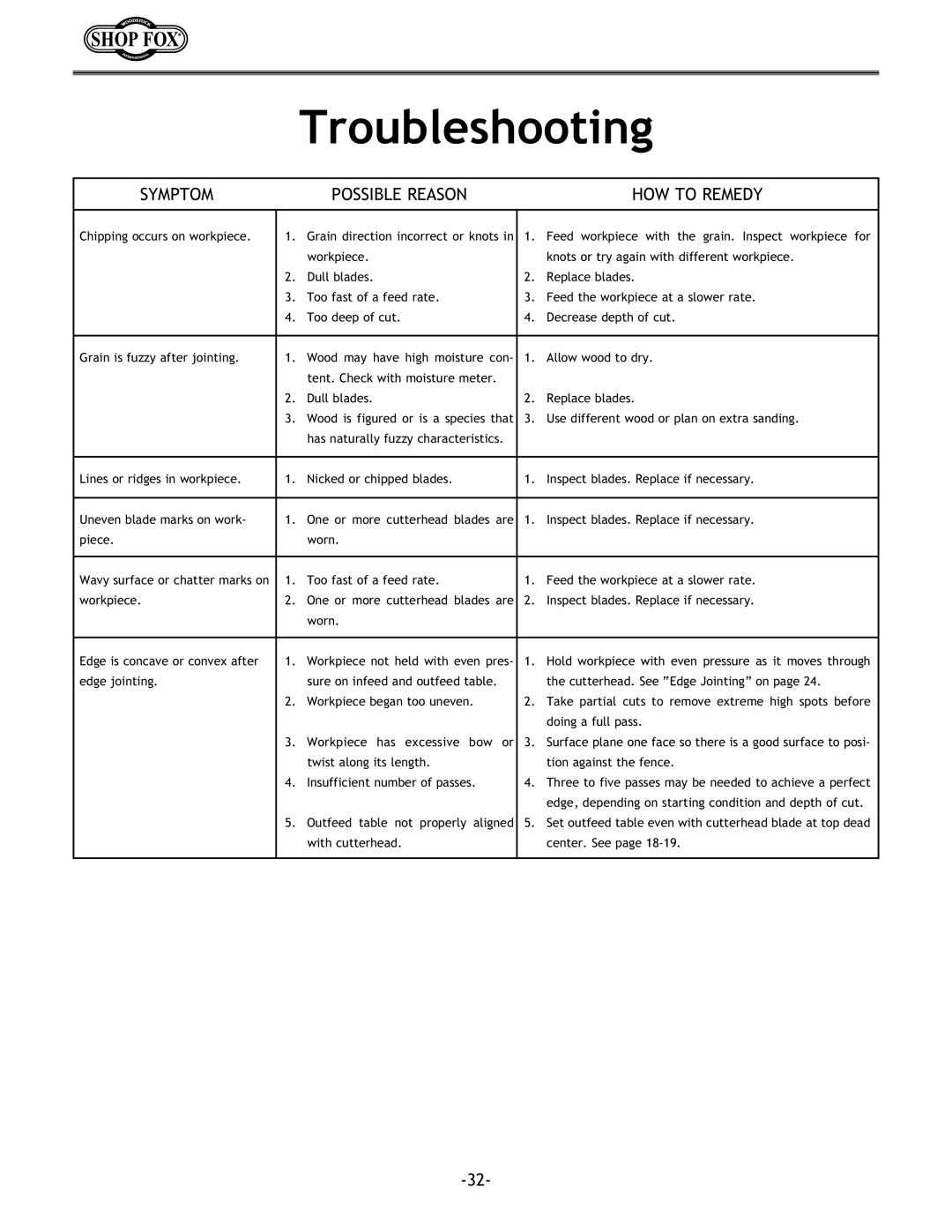
Troubleshooting
|
|
|
|
|
|
|
|
|
| SYMPTOM |
|
| POSSIBLE REASON |
|
| HOW TO REMEDY |
|
|
|
|
|
|
|
|
|
|
| Chipping occurs on workpiece. |
| 1. | Grain direction incorrect or knots in |
| 1. | Feed workpiece with the grain. Inspect workpiece for |
|
|
|
|
| workpiece. |
|
| knots or try again with different workpiece. |
|
|
|
| 2. | Dull blades. |
| 2. | Replace blades. |
|
|
|
| 3. | Too fast of a feed rate. |
| 3. | Feed the workpiece at a slower rate. |
|
|
|
| 4. | Too deep of cut. |
| 4. | Decrease depth of cut. |
|
|
|
|
|
|
|
|
|
|
| Grain is fuzzy after jointing. |
| 1. | Wood may have high moisture con- |
| 1. | Allow wood to dry. |
|
|
|
|
| tent. Check with moisture meter. |
|
|
|
|
|
|
| 2. | Dull blades. |
| 2. | Replace blades. |
|
|
|
| 3. | Wood is figured or is a species that |
| 3. | Use different wood or plan on extra sanding. |
|
|
|
|
| has naturally fuzzy characteristics. |
|
|
|
|
|
|
|
|
|
|
|
|
|
| Lines or ridges in workpiece. |
| 1. | Nicked or chipped blades. |
| 1. | Inspect blades. Replace if necessary. |
|
|
|
|
|
|
|
|
|
|
| Uneven blade marks on work- |
| 1. | One or more cutterhead blades are |
| 1. | Inspect blades. Replace if necessary. |
|
| piece. |
|
| worn. |
|
|
|
|
|
|
|
|
|
|
|
|
|
| Wavy surface or chatter marks on |
| 1. | Too fast of a feed rate. |
| 1. | Feed the workpiece at a slower rate. |
|
| workpiece. |
| 2. | One or more cutterhead blades are |
| 2. | Inspect blades. Replace if necessary. |
|
|
|
|
| worn. |
|
|
|
|
|
|
|
|
|
|
|
|
|
| Edge is concave or convex after |
| 1. | Workpiece not held with even pres- |
| 1. | Hold workpiece with even pressure as it moves through |
|
| edge jointing. |
|
| sure on infeed and outfeed table. |
|
| the cutterhead. See “Edge Jointing” on page 24. |
|
|
|
| 2. | Workpiece began too uneven. |
| 2. | Take partial cuts to remove extreme high spots before |
|
|
|
|
|
|
|
| doing a full pass. |
|
|
|
| 3. | Workpiece has excessive bow or |
| 3. | Surface plane one face so there is a good surface to posi- |
|
|
|
|
| twist along its length. |
|
| tion against the fence. |
|
|
|
| 4. | Insufficient number of passes. |
| 4. | Three to five passes may be needed to achieve a perfect |
|
|
|
|
|
|
|
| edge, depending on starting condition and depth of cut. |
|
|
|
| 5. | Outfeed table not properly aligned |
| 5. | Set outfeed table even with cutterhead blade at top dead |
|
|
|
|
| with cutterhead. |
|
| center. See page |
|
|
|
|
|
|
|
|
|
|
|
|
|
|
|
|
|
|
|
|
|
|
|
|
|
|
|
|
